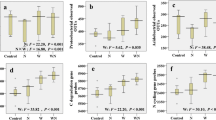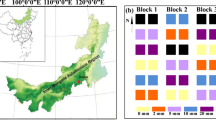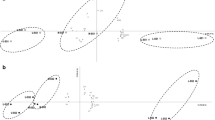Abstract
The hypothesis that positive links exist among plant taxonomic diversity, belowground microbial taxonomic and metabolic diversities was tested for four secondary vegetation successional stages (tussock (T), shrub (S), secondary forest (SF) and primary forest (PF)) in Huanjiang county, SW China. Soil bacterial communities were characterized by DNA fingerprinting and metabolic profiling. Along the succession, Shannon diversity indices followed the order SF>PF>S>T for plant taxonomic diversity, T>SF>PF>S for bacterial operational taxonomic diversity, SF>T>S>PF for fungal operational taxonomic diversity, and SF>PF>S>T for bacterial metabolic diversity. Significant positive correlations were found between bacterial and fungal taxonomic diversities. However, there was no significant correlation between soil microbial taxonomic diversity and bacterial metabolic diversity. Two-way ANOVA revealed that vegetation and season, as well as their interaction, had significant effects on soil microbial (fungal and bacterial) taxonomic diversities, but that there were no seasonal effects on metabolic diversity. However, PCA and MANOVA revealed highly significant differences among the bacterial community-level physiological profiles, reflecting the successional sequence. The findings from this survey support the notion that there are strong interactions between aboveground and belowground communities and suggest that bacterial metabolic and plant taxonomic diversities, but not microbial taxonomic and metabolic diversities, can be correlated.





Similar content being viewed by others
Notes
GC-clamp sequence: 5′-CGCCCGGGGCGCGCCCCGGGCGGGGCGGGGGCACGGGGGG-′
Abbreviations
- CLPP:
-
Community-level physiological profiling pattern
- DGGE:
-
Denaturing gradient gel electrophoresis
- EDTA:
-
Ethylene diamine tetraacetic acid
- MANOVA:
-
Multivariate analysis of variance
- PCA:
-
Principle component analysis
- PC:
-
Principle component
- PCR:
-
polymerase chain reaction
- UPGMA:
-
Unweighted pair group method with arithmetic mean
References
Artursson V, Finlay RD, Jansson JK (2005) Combined bromodeoxyuridine immunocapture and terminalrestriction fragment length polymorphism analysis highlights differences in the active soil bacterial metagenome due to Glomus mosseae inoculation or plant species. Environ Microbiol 7:1952–1966
Bever JD (1994) Feedback between plants and their soil communities in an old field community. Ecology 75:1965–1977
Bever JD (2002) Host-specificity of AM fungal population growth rates can generate feed-back on plant growth. Plant Soil 244:281–290
Bossio DA, Scow KM, Gunapala N, Graham KJ (1998) Determinants of soil microbial communities: effects of agricultural management, season, and soil type on phospholipid fatty acid profiles. Microb Ecol 36:1–12
Bossio DA, Girvan MS, Verchot L, Bullimore J, Borelli T, Albrecht A, Scow KM, Ball AS, Pretty JN, Osborn AM (2005) Soil microbial community response to land use change in an agricultural landscape of western Kenya. Microb Ecol 49:50–62
Cardinale BJ, Wright JP, Cadotte MW, Carroll IT, Hector A, Srivastav DS, Loreau M, Weis JJ (2007) Impacts of plant diversity on biomass production increase through time because of species complementarity. PNAS 104:18123–18128
Carney KM, Matson PA (2006) The influence of tropical plant diversity and composition on soil microbial communities. Microb Ecol 52:226–238
Chabrerie O, Laval K, Puget P, Desaire S, Alard D (2003) Relationship between plant and soil microbial communities along a successional gradient in a chalk grassland in north-western France. Appl Soil Ecol 24:43–56
Chris L, Richard F (2006) A resource-based conceptual model of plant diversity that reassesses causality in the productivity-diversity relationship. Glob Ecol Biogeogr 15:213–224
Costa R, Götz M, Mrotzek N, Lottmann J, Berg G, Smalla K (2006) Effects of site and plant species on rhizosphere community structure as revealed by molecular analysis of microbial guilds. FEMS Microbiol Ecol 56:236–249
Crecchio C, Gelsomino A, Ambrosoli R, Minati JL, Ruggiero P (2004) Functional and molecular responses of soil microbial communities under differing soil management practices. Soil Biol Biochem 36:1873–1883
Crecchio C, Curci M, Pellegrino A, Ricciuti P, Tursi N, Ruggiero P (2007) Soil microbial dynamics and genetic diversity in soil under monoculture wheat grown in different long-term management systems. Soil Biol Biochem 39:1391–1400
De Deyn GB, Van der Putten WH (2005) Linking aboveground and belowground diversity. TREE 20:625–633
Doran JW, Zeiss MR (2000) Soil health and sustainability: managing the biotic component of soil quality. Appl Soil Ecol 15:3–11
Ferris MJ, Muyzer G, Ward DM (1996) Denaturing gradient gel electrophoresis profiles of 16S rRNA-defined populations inhabiting a hot spring microbial mat community. Appl Environ Microb 62:340–346
Fierer N, Bradford MA, Jackson RB (2007) Toward an ecological classification of soil bacteria. Ecology 88:1354–1364
Garland JL (1996) Patterns of potential C source utilization by rhizosphere communities. Soil Biol Biochem 28:223–230
Garland JL (1997) Analysis and interpretation of community-level physiological profiles in microbial ecology. FEMS Microbiol Ecol 24:289–300
Gelsomino A, Cacco G (2006) Compositional shifts of bacterial groups in a solarized and amended soil as determined by denaturing gradient gel electrophoresis. Soil Biol Biochem 38:91–102
Glimm E, Heuer H, Engelen B, Smalla K, Backhaus H (1997) Statistical comparisons of community catabolic profiles. J Microbiol Methods 30:71–80
Heuer H, Hartung K, Wieland G, Kramer I, Smalla K (1999) Polynucleotide probes that target a hypervariable region of 16s rRNA genes to identify bacterial isolates corresponding to bands of community fingerprints. Appl Environ Microb 65:1045–1049
Hooper DU, Bignell DE, Brown VK, Brussaard L, Dangerfield JM, Wall DH, Wardle DA, Coleman DC, Giller KE, Lavelle P, Van der Putten WH, De Ruiter PC, Rusek J, Silver WL, Tiedje JM, Wolters V (2000) Interactions between aboveground and belowground biodiversity in terrestrial ecosystems: patterns, mechanisms, and feedbacks. Bioscience 50:1049–1061
Kardol P, Cornips NJ, Van Kempen MML, Bakx-Schotman JMT, Van Der Putten WH (2007) Microbe-mediated plant–soil feedback causes historical contingency effects in plant community assembly. Ecol Monogr 77:147–162
Klose S, Wernecke KD, Makeschin F (2004) Microbial activities in forest soils exposed to chronic depositions from a lignite power plant. Soil Biol Biochem 36:1913–1923
Kohlmeier S, Smits THM, Ford RM, Keel C, Harms H, Wick LY (2005) Taking the fungal highway: Mobilization of pollutant-degrading bacteria by fungi. Environ Sci Technol 39:4640–4646
Krave AS, Lin B, Braster M, Laverman AM, van Straalen NM, Röling WFM, van Verseveld HW (2002) Stratification and seasonal stability of diverse bacterial communities in a Pinus merkusii (pine) forest soil in central Java, Indonesia. Environ Microbiol 4(6):361–373
Li YB, Hou JJ, Xie DT (2002) The recent development of research on karst ecology in Southwest China (in Chinese). Scientia Geographica Sinica 22:365–370
Liu ZF, Liu GH, Fu BJ, Zheng XX (2007) Relationship between plant species diversity and soil microbial functional diversity along a longitudinal gradient in temperate grasslands of Hulunbeir, Inner Mongolia, China. Ecol Res. DOI 10.1007/s11284–007–0405–9
Lupway NZ, Rice WA, Clayton GW (1998) Soil microbial diversity and community structure under wheat as influenced by tillage and crop rotation. Soil Biol Biochem 30:1733–1741
Magurran AE (2004) Measuring biological diversity. Blackwell Publishing, Oxford, pp 107–130
May LA, Smiley B, Schmidt MG (2001) Comparative denaturing gradient gel electrophoresis of fungal communities associated with whole plant corn silage. Can J Microbiol 47:829–841
McGill WB, Cannon KR, Robertson JA, Cook FD (1986) Dynamics of soil microbial biomass and water soluble organic C in Breton L after 50 years of cropping to two rotations. Can J Soil Sci 66:1–19
Monson RK, Lipson DA, Burns SP, Turnipseed AA, Delany AC, Williams MW, Schmidt SK (2006) Winter forest soil respiration controlled by climate and microbial community composition. Nature 439:711–714
Müller AK, Westergaard K, Christensen S, Sørensen SJ (2002) The diversity and function of soil microbial communities exposed to different disturbances. Microb Ecol 44:49–58
Muyzer G, de Waal EC, Uitterlinden AG (1993) Profiling of complex microbial populations by denaturing gradient gel electrophoresis analysis of polymerase chain reaction-amplified genes coding for 16S rRNA. Appl Environ Microb 59:695–700
Naeem S, Li SB (1997) Biodiversity enhances ecosystem reliability. Nature 390:507–509
O’Donnell AG, Seasman M, Macrae A, Waite I, Davies JT (2001) Plants and fertilizers as drivers of change in microbial community structure and function in soils. Plant Soil 232:135–145
Ou ZL, Li XK, Su ZM (2005) Population variation and species diversity in the succession process of karst vegetation in Yangshuo, Guangxi (in Chinese). Ecol Sci 24:295–297
Ouyang ZY (1998) On the comprehensive management, development and keeping away from poorness of the ecologically fragile karst area in south-west China (in Chinese). World Sci Tech Res Dev 20:53–56
Pan GX, Cao JH (1999) Karstification in epikarst zone: the earth surface ecosystem processes taking soil as a medium – case of the Yaji karst experiment site, Guilin (in Chinese). Carsologica Sinica 18:287–296
Pärtel M, laanisto L, Zobel M (2007) Contrasting plant productivity–diversity relationships across latitude: the role of evolutionary history. Ecology 88:1091–1097
Qiu S, McComb AJ, Bell RW, Davis JA (2005) Response of soil microbial activity to temperature, moisture, and litter leaching on a wetland transect during seasonal refilling. Wetlands Ecol Manag 13:43–54
Rodríguez-Loinaz G, Onaindia M, Amezaga I, Mijangos I, Garbisu C (2008) Relationship between vegetation diversity and soil functional diversity in native mixed-oak forests. Soil Biol Biochem 40:49–60
Rogers BF, Tate RL (2001) Temporal analysis of the soil microbial community along a toposequence in Pineland soils. Soil Biol Biochem 33:1389–1401
Schmidt SK, Lipson DA (2004) Microbial growth under the snow: implications for nutrient and alleochemical availability in temperate soils. Plant Soil 259:1–7
Schmidt SK, Costello EK, Nemergut DR, Cleveland CC, Reed SC, Weintraub MN, Meyer AF, Martin AM (2007) Biogeochemical consequences of rapid microbial turnover and seasonal succession in soil. Ecology 88:1379–1385
Scow KM, Bruns MA, Graham K, Bossio D, Schwartz E (1998) Development of indices of microbial community structure for soil quality assessment. In: Zabel A, Sposito G (eds) Soil quality in the California environment. Kearney Foundation of Soil Science Annual Report of Research Projects 1997–1998. Kearney Foundation of Soil Science, USA, pp 110–123
Sharma S, Szele Z, Schilling R, Munch JC, Schloter M (2006) Influence of freeze-thaw stress on the structure and function of microbial communities and denitrifying populations in soil. Appl Environ Microbiol 72:2148–2154
Singh BK, Nunan N, Ridgway KP, McNicol J, Young JPW, Daniell TJ, Prosser JI, Millard P (2008) Relationship between assemblages of mycorrhizal fungi and bacteria on grass roots. Environ Microbiol 10:534–541
Tilman D (1999) The ecological consequences of changes in biodiversity: a search for general principles. Ecology 80:1455–1474
Tilman D, Downing JA (1994) Biodiversity and stability in grasslands. Nature 367:363–365
Tilman D, Knops J, Wedin D, Reich P, Ritchie M, Siemann E (1997) The influence of functional diversity and composition on ecosystem processes. Science 277:1300–1305
Toljander JF, Lindahl BD, Paul LR, Elstrand M, Finlay RD (2007) Influence of arbuscular mycorrhizal mycelial exudates on soil bacterial growth and community structure. FEMS Microbiol Ecol 61:295–304
van der Heijden MGA, Bardgett RD, van Straalen NM (2008) The unseen majority: soil microbes as drivers of plant diversity and productivity in terrestrial ecosystems. Ecol Lett 11:296–310
Vitousek PM, Aber JD, Howarth RW, Likens GE, Matson PA, Schindler DW, Schlesinger WH, Tilman DG (1997) Human alteration of the global nitrogen cycle: sources and consequences. Ecol Appl 7:737–750
Wallenstein MD, McMahon S, Schimel J (2007) Bacterial and fungal community structure in Arctic tundra tussock and shrub soils. FEMS Microbiol Ecol 59:428–435
Wardle DA, Bardgett RD, Klironomos JN, Setälä H, van der Putten WH, Wall DH (2004) Ecological linkages between aboveground and belowground biota. Science 304:1629–1633
Weber KP, Grove JA, Gehder M, Anderson WA, Legge RL (2007) Data transformations in the analysis of community-level substrate utilization data from microplates. J Microbiol Methods 69:461–469
Wertz S, Degrange V, Prosser JI, Poly F, Commeaux C, Freitag T, Guillaumaud N, Le Roux X (2006) Maintenance of soil functioning following erosion of microbial diversity. Environ Microbiol 8:2162–2169
Wilson GWT, Hartnett DC (1997) Effects of mycorrhizae on plant growth and dynamics in experimental tallgrass prairie microcosms. Am J Bot 84:478–482
Yao CH, Jiang ZC, Yuan DX (2001) Vegetation effects on karst physiognomy in southwest China (in Chinese). Acta Geoscientia Sinica 22:159–164
Yao HY, Bowman D, Shi W (2006) Soil microbial community structure and diversity in a turfgrass chronosequence: land-use change versus turfgrass management. Appl Soil Ecol 34:209–218
Yuan DX (1991) Karst of China. Geological Publishing House, Beijing, p 1–9
Zak JC, Willig MR, Moorhead DL, Wildman HG (1994) Functional diversity of microbial communities: a quantitative approach. Soil Biol Biochem 26:1101–1108
Zogg GP, Zak DR, Ringelberg DB, MacDonald NW, Pregitzer KS, White DC (1997) Compositional and functional shifts in microbial communities due to soil warming. Soil Sci Soc Am J 61:475–481
Acknowledgements
We thank Zongming Su (Guangxi Institute of Botany, Guangxi Zhuangzu Autonomous Region and the Chinese Academy of Sciences, China) and Yuanhe Huang (Youjiang Medical College for Nationalities) for their assistance in the vegetation survey. Many thanks to Jizheng He, Yong Zheng and Jupei Shen (Research Center for Eco-Environmental Sciences, the Chinese Academy of Sciences) for technical assistance with molecular analyses, and to Wenxue Wei, Pedro Rocha (Institute of Subtropical Agriculture, the Chinese Academy of Sciences) for their valuable comments on previous versions of the manuscript, and to two anonymous reviewers for their precious comments on the first submitted version of the manuscript. This project was supported by the National Key Basic Research Development Foundation of China (no. 2006CB403208) and the Chinese Academy of Sciences Western Action Program (no.KZCX2-XB2–08) and the Western Light Program of Talent Cultivation of the Chinese Academy of Sciences.
Author information
Authors and Affiliations
Corresponding author
Additional information
Responsible Editor: Angela Hodge.
Rights and permissions
About this article
Cite this article
He, XY., Wang, KL., Zhang, W. et al. Positive correlation between soil bacterial metabolic and plant species diversity and bacterial and fungal diversity in a vegetation succession on Karst. Plant Soil 307, 123–134 (2008). https://doi.org/10.1007/s11104-008-9590-8
Received:
Accepted:
Published:
Issue Date:
DOI: https://doi.org/10.1007/s11104-008-9590-8




